The Intercepts Theme
The intercepts theme is the simplest theme in the game from a design point of view. The reason for this is that placing intercepts is, at least compared to other themes, technically easy to implement. Although stacking periodic enemies is conceptually simple, the designer has to account for the interplay of two heterogeneous periods, and allow a window of time in which the player can move or jump. Thus, the periodic enemies theme can get quite technically difficult for the designer building it, even if the idea behind it is simple. The intercepts theme, on the other hand, isn't about timing; it's about reactions. This fact gives the designer more leeway, and probably made for fairly simple construction. Indeed, the Intercepts theme is one of the geographically simplest themes in the game, as each level will show. Most intercepts levels have as their most geographically complex feature a short section of platforms at alternating heights.

The platforms and jumps themselves are not meant to be difficult; this theme has a medium-sized d-distance and delta-height, but has the largest average platform size for both launching and landing platforms--even larger than those in the preservation of momentum. The whole point of this theme is to get Mario into a situation where he's making a geographically simple jump, and then complicate that jump with intercepts.
What makes this theme easy for the designer but challenging for the player is that levels can become intricate without much iteration. By Vanilla Dome 4, all the types of intercepts have appeared already, and all that remains for the designer is to mix and match them.

Above we have the tracking, linear, overhead, bouncing and swooping/descending intercepts, the mix of which constitutes the bulk of this theme’s content. There are definitely cases where they mix and are not technically accumulations, but they can often feel like them to the player. The most technical definition of an accumulation gives us a challenge in which two elements of a skill theme are overlaid to create enhanced difficulty. The most technical definition of an intercept is an enemy or obstacle which modifies a jump Mario has already taken. These shots are from Vanilla Dome 4 and Butter Bridge 2, respectively. They don’t exactly match the technical definition of an intercept accumulation.

So although in these cases there are only two types of enemies coming at Mario, the shift from pitfall intercepts to layered enemies is one that accomplishes the same thing as an accumulation. It’s an increase in complexity without the introduction of a novel element. In the end, the technical definitions of intercepts and accumulations are only tools to help us systematically understand the game. Sometimes those definitions aren’t going to be as useful as other times, and the intercepts theme shows us why.
There are real accumulations, though, and that is where this theme gets interesting. Cookie Mountain reveals the context of the last key ingredient in intercept accumulations: the ground-based intercept. This isn’t the Monty Mole’s first appearance, but it is his first appearance in quantities and contexts that take advantage of his intercept behaviors.

The Monty Mole’s ability to track Mario is the key addition here. Without tracking, there are very few situations in which a ground-based enemy can be an intercept. (Note that although the Chuck is frequent in the early game and will track Mario, he is almost always implemented in an open “arena” setting until the end of this theme. Since that kind of implementation has little to do with reflexes, it has little to do with the intercepts theme by this point in the game.) It only makes sense that mixing and matching intercepts is a lot easier if the designer can also use the ground. Without ground-based intercepts, accumulations would all be like Butter Bridge 2. With them, we have these challenges instead.

Outrageous, naturally, takes the accumulations to a spectacular extreme. Interestingly, on the path toward the pinnacle level of Outrageous, the design team introduces the Dino-Rhino which is the most dangerous ground-based intercept. The lack of the Dino-Rhino is the only noteworthy omission from Outrageous. The problem is that the Dino-Rhino is so dangerous that the designers actually have to abandon it almost immediately after introducing it in Chocolate Island 1. Few challenges after this point involve it at all, and none in a cadence progression. This enemy would have been pretty easy to implement, but any more intercepts and the level would have been too hard. This is another sign that intercepts can be an easy tool for designers to use in platformers, but that their ease of implementation has no relation to the difficulty of a level, and in some cases the two factors can actually correlate inversely.
DONUT PLAINS 2
Donut Plains 2 introduces the intercepts theme by slowing down the pace of the level to a controlled crawl. Most levels in the intercepts theme incline toward a faster pace, but this one does not because the goal of this level is to teach players about the intercepts theme without simply throwing them into it. The central idea in the intercepts theme is to get the player to react, and modify Mario’s run or jump-path. To that end, this level offers three things, the first of which is a set scroll speed that prevents the player from rushing Mario through the challenges. The second and third things that prevent rushing are uneven terrain and the Swooper enemy. Both of these features cause new players to make last-second decisions while moving, which is the foundation of the intercepts’ set of reaction skills. The warning shots in this level are fairly obvious: these Buzzy Beetles are not hard because there’s plenty of overhead space to jump.


On the other hand, the Swoopers pictured above are not terribly dangerous either, since they’re going to simply fly through the inaccessible regions of the bedrock. The important part is that, as part of a warning shot, it will at least provide fair warning as to the Swooper’s irregular flight path.
There’s a fairly obvious progression in the level that involves putting Mario in the same basic situation over and over again: Beetles followed by Swoopers on top of undulating platforms. Here we can see the first really dangerous encounter with a Swooper.


The Swooper’s bending flight path intercepts Mario’s path, but also takes place in a corridor that makes jumping tricky and forces Mario to wait until the last second to take that jump (or use a cape attack). This happens throughout the level, and it makes for a lot of last-second reactions. The second example shown above is an expansion/evolution, as not only are there two Swoopers, but their flight paths will intercept Mario as he’s ascending. Mario’s ascent makes reacting to the Swoopers more difficult, as the player will have to mentally calculate how to best attack the enemy at two different points in its oddly-shaped flight path.
For the third instance of the Swooper’s path, the level uses a mutation upon the previous expansion challenge. These Swoopers are roughly the same height above Mario as in the standard challenge, but this time Mario is descending—whether the player wants to or not, because of the rising and falling platforms.

This descent is particularly good about emphasizing the value of the cape-glide, which is a skill brand new to the player at this point in the game. One of the essential skills involved in making the cape-glide work is adjusting Mario’s path mid-flight, which these Swoopers force the player to do. The final challenge featuring the Swoopers sees them crowded into a narrow corridor, just high enough that their arc will intercept Mario’s walking path before they fly off screen. This is an example of the expansion-by-contraction which will appear frequently in this theme.

To dial up the difficulty for this challenge, the designers added an A+B evolution element, including the Buzzy Beetle on the ground. The slowness of the level’s scroll speed prevents this from tangling the player up too much, but it at least provides a good chance for the player to synthesize some skills at the end of the level.
During the rest of the level, the Buzzy Beetles have been serving the purpose of teaching the player how to use the cape’s offensive spinning ability. The essential property of these enemies is that they’re immune to fireballs, and so have to be defeated with jumps or other lateral attacks (like the cape). In a level with low ceilings, the lateral attack becomes much easier—but they’re not too easy. The designers made sure that the Beetles mostly appear on uneven ground. Even the most inexperienced players can figure out how to do an ordinary cape-spin on level ground; mastery involves being able to do it when the ground isn’t level, because that involves mixing the jump and the spin in a number of different ways, depending on context. So naturally, Beetle encounters in this level rarely happen on flat planes.


The first encounters are all obvious: the Beetles are coming down the slope, visible from far off, and their path and speed are easy to estimate. On terrain that is more varied like you see above, the player needs to have the right timing to avoid a situation where the enemy is descending and Mario can’t take advantage of the usually easy hitbox most enemies have on their jump-prone tops. Overall, this is a simple level that still manages to be frustrating because of the dragging pace. The designers felt that slow pace was necessary to help players learn about intercepts, and the decision has its merits. Unlike in some of the other skill themes, there’s no obvious way to make a training-wheels challenge out of intercepts. How would it be possible to implement enemies without having them do any damage? Thus, the tedium of this level represents a problem that the designers couldn’t get around without adding extraneous elements to their game, something they have proven time and again that they would not do.
DONUT SECRET 1
This level does many things that the Ghost Houses also do, although it does them more effectively, probably because the designers didn’t have to spend any energy on designing puzzles. In a water level, combat changes significantly because Mario is vulnerable from below. The problems presented by uneven terrain in Donut Plains 2 are magnified here that much more; getting a clear shot on the enemies is more difficult. The primary intercept in this level is the Rip Van Fish, who will follow Mario after he enters the fish’s aggro radius. The Rip Van Fish (hereafter RVF) shares a behavioral property with the Boo: both enemies follow Mario imperfectly. The RVF’s flaw is that it tends to pull up too high and overshoot Mario in that manner. This makes evasion possible, but it also makes combat slightly more difficult for new players who have not yet internalized this property.

Because players have to either position Mario parallel to a fish (for the cape) or take a specific superior angle for fireballs, the first few encounters with RVFs can be tricky. And this says nothing of whole challenges in the level, which do more than simply throw one RVF at Mario.
There’s probably no better example of a warning shot covering all of a level’s elements than this one right here. The first screen introduces the player to every kind of fish and displays their behaviors.

For the rest of the level, the following things will happen: RVFs will seek Mario, Blurps will swim in straight lines, and the white fish will patrol certain spaces. This also highlights just how much the designers accomplished with only three types of enemies: the subsequent challenges provide a decent amount of variety using only what is presented here.
The standard challenge for the level, which you can see below, features an RVF that chases Mario into two other enemies. Now, because of the “pulling up” behavior of the RVF, it will almost certainly overshoot Mario, but new players aren’t going to know this yet, and so they’ll try to quickly shoot down into the gap.
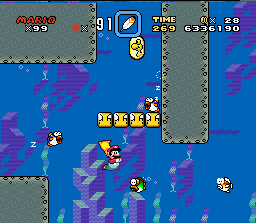
It’s this gap that provides the player with a true intercepts-based situation. While swimming, Mario is engaged in one continuous jump. For this reason, it can be hard to identify a situation where the “term” intercept is meaningful. In dry levels, intercepts are defined by their action of forcing the player to modify Mario’s jump-path, often at the last available moment. If Mario is always jumping while he swims, every enemy becomes an intercept, and so the term doesn’t give us any special insight into a water level. Therefore, in a water level, it’s useful not to redefine “intercept,” but to redefine “jump” for intercepts situations. For the purposes of water levels, almost anything can be a jump, but we can narrow it down here to any situation in which Mario has to accelerate, since this acceleration takes the form of the player rapidly pressing the jump button as well as keeping the directional pad pressed towards safety. Thus, these two little guys are intercepts, because Mario is accelerating towards them to avoid the RVF. Fireballs are an easy solution here, but if Mario isn’t using that powerup, it’s still possible to simply flatten out his path and avoid both enemies. This possibility will disappear in later evolutions.
Next there is an expansion-by-contraction that brings Mario close to combat, although it’s still possible to avoid combat should the player want to choose that path. Indeed, combat is the best solution here, but the low ceiling means that even with fireballs, Mario will have to get in very close to get the right angle to snipe the RVF. Now, if the RVF isn’t engaged and defeated, it will chase Mario into these two syncopated Blurps.
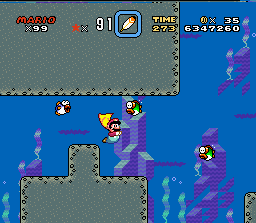
By syncopated I mean any enemies who are parallel and moving at the same speed, but which come at an off-set interval, so that it’s clear that Mario is supposed to sneak between them. (This is something Mario will do frequently in water levels.) Because Blurps are so predictable, the gap isn’t hard to squeeze through, although because of the physics of water levels, having Mario sink to the appropriate height in preparation for that gap is tricky when being chased by a RVF.
The next significant challenge is this one, an evolution/expansion that increases the number of RVFs on screen, and also evolves their situation to surround Mario, making evasion a more complex task.
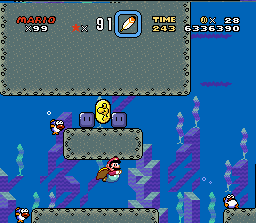
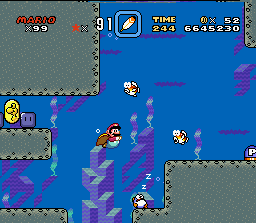
The two patrolling fish aren’t any harder than what’s come before, because although they’re syncopated, it’s only very slightly so. The real problem is that the two RVFs could easily follow Mario into the next challenge. This challenge is a simple expansion-by-contraction of two challenges ago. Instead of two Blurps syncopated at 4 spaces, there are two patrolling fish syncopated two spaces apart. It’s also an evolution because unlike the earlier Blurps, these two are going back in the other direction once they complete their patrol.
Subsequently we have a challenge that is a definite example of the rare de-evolution, but it’s one with an interesting purpose. This Blurp is positioned so that the player either must defeat it by combat (which can be tricky, because the ceiling makes fireballs difficult here) or must quickly discover how low the fatal “bottom” of the level is. Waiting is an option, but waiting is something players tend not to like.

It’s interesting that the designers are able to do so much with just one Blurp positioned correctly, in the correct geography, but it’s a good object lesson. Not all challenges need to increase in difficulty in a linear fashion, or even increase at all. Sometimes there’s a “just right” challenge that can get across a design lesson with a minimum of effort.
The next challenge is a reiteration of the third challenge in this level, with changes so minor that they don’t bear explanation.
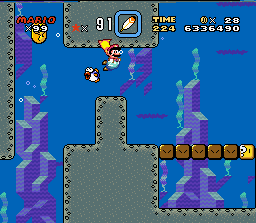
Want to read more? The rest of this section can be found in the print and eBook versions.